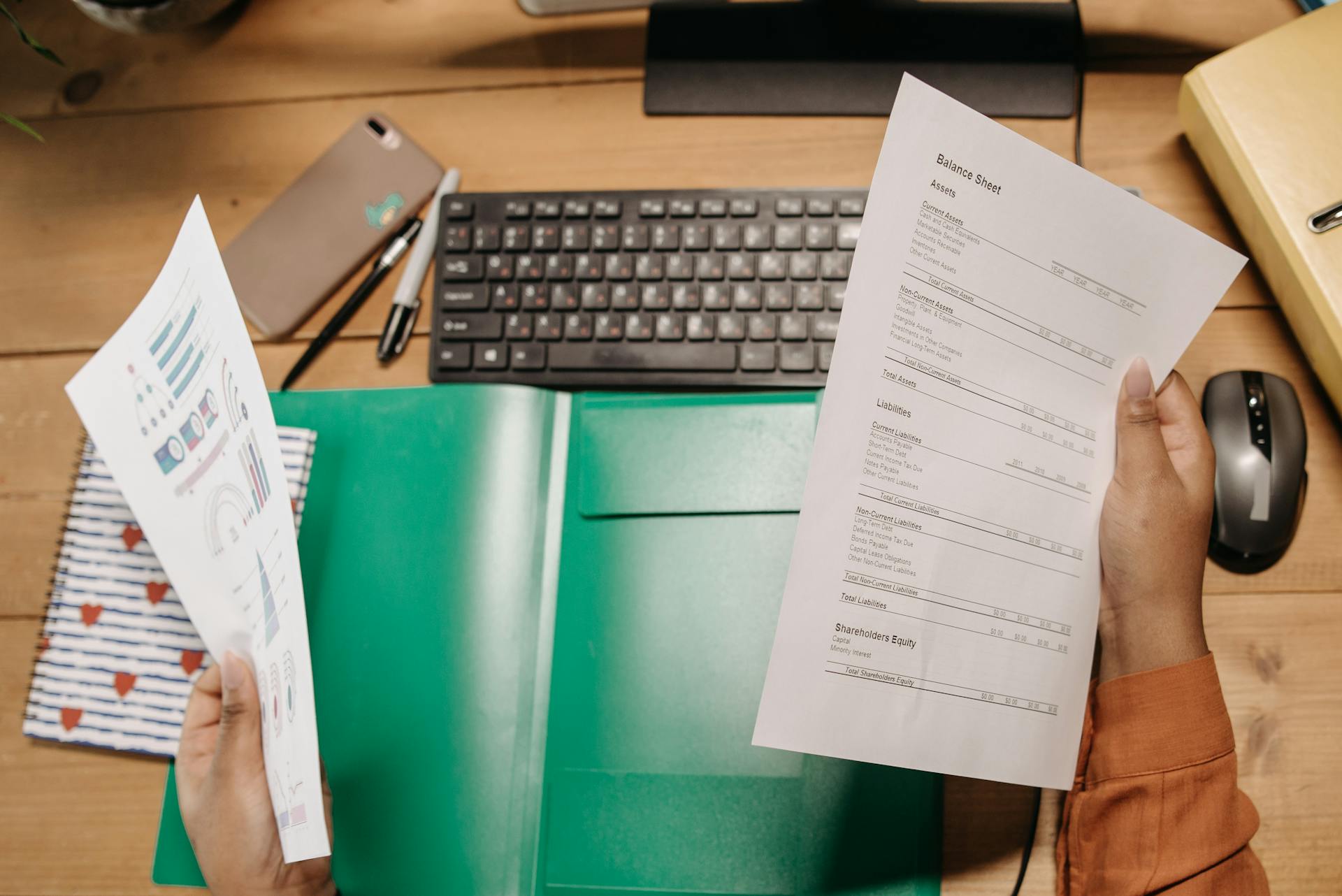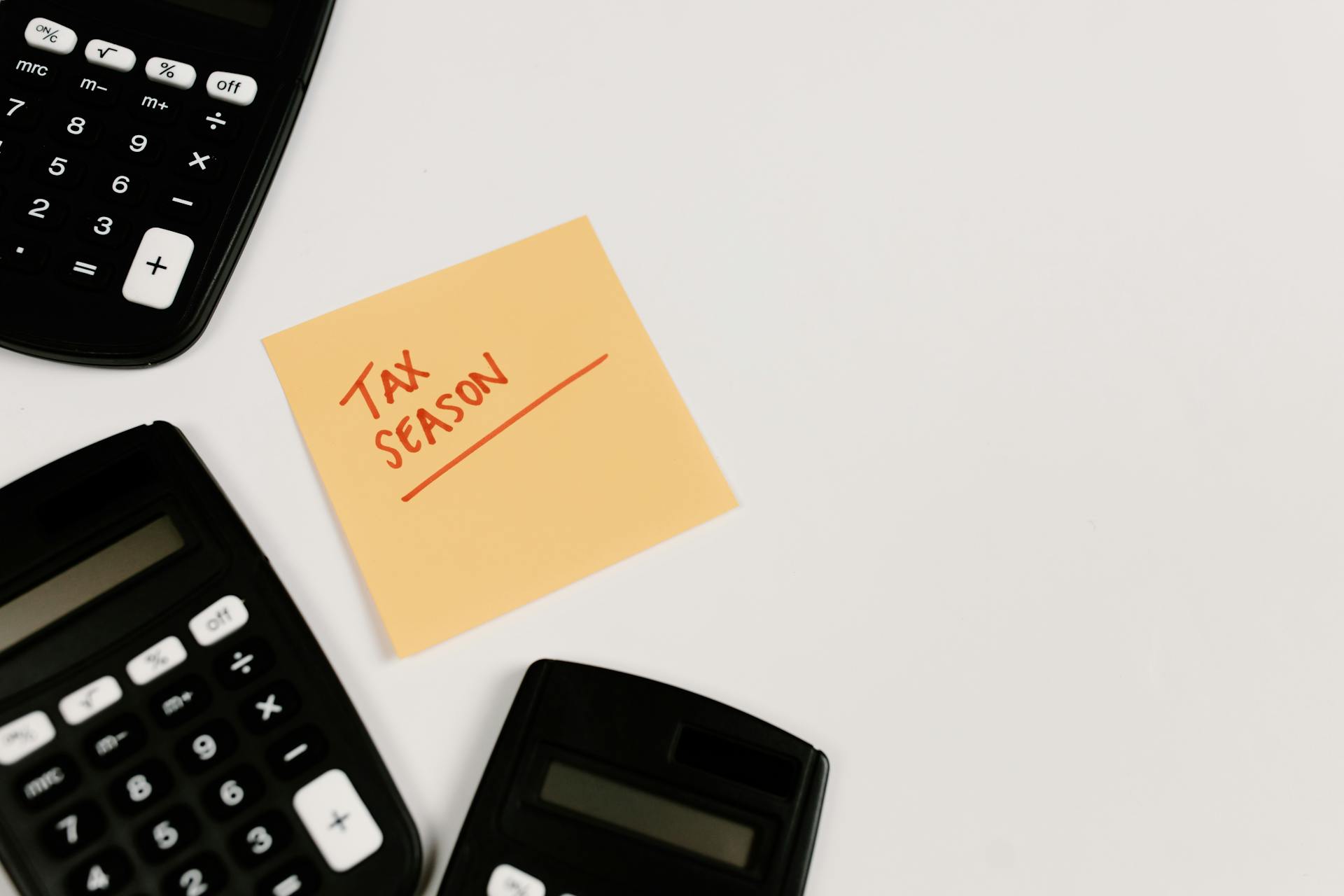
As a business owner, it's essential to understand the difference between assets and liabilities in accounting. Assets are valuable resources that can be used to generate revenue or reduce expenses, such as cash, inventory, and property.
Assets can be categorized into current and non-current assets. Current assets are expected to be converted into cash within a year or less, like accounts receivable and prepaid rent. Non-current assets, on the other hand, have a longer lifespan, such as equipment and land.
Liabilities, however, are debts or obligations that must be paid off in the future. They can be current, like accounts payable and taxes owed, or non-current, like loans and mortgages.
Equity
Equity is the difference between a company's total assets and its total liabilities. This is calculated by subtracting all that a company owes from all that it owns.
Equity often includes investments made by business owners or other investors through the purchase of shares. Essentially, equity represents what's left over after a company has settled its obligations.
The balance sheet, which records a company's assets, liabilities, and equity, is sometimes referred to as a statement of net worth or a statement of financial position. This statement summarizes the financial position of a firm at a glance.
For more insights, see: Net Assets and Equity
Understanding Equity
Equity is essentially what's left over after a company has subtracted all that it owes from all that it owns. This difference between a company's total assets and its total liabilities is its equity.
Equity can also include investments into the business by the business owners or other investors through the purchase of shares. This means that equity is not just a simple calculation, but also reflects the company's ownership structure.
A company's equity is recorded on its balance sheet, which is also known as a statement of net worth or a statement of financial position. This statement summarizes the financial position of a firm at a glance, showing all the assets, liabilities, and equity.
The balance sheet is a crucial tool for understanding a company's financial health, and equity is a key component of this statement.
Debt Ratio
The debt ratio is a crucial equation in credit accounting that helps you understand how leveraged your business is by comparing your total liabilities to your total assets. It's a simple yet powerful tool that can give you a clear picture of your business's financial health.
Curious to learn more? Check out: Difference between Business Bank Account and Personal
A debt ratio of 40% or lower is generally considered safe, while a ratio of 60% or higher may raise concerns among investors and lenders. Annie's Pottery Palace, for example, has a debt ratio of 31.8%, which indicates that it's not too heavily burdened by debt.
The debt ratio equation is straightforward: Total liabilities / Total assets. For Annie's Pottery Palace, this would be $7,000 / $22,000. The lower the debt ratio, the more capable your business is of paying off its debts.
Here's a quick reference guide to help you understand what debt ratio means:
A lower debt ratio is generally a good sign, as it indicates that your business is not too heavily reliant on debt to operate. On the other hand, a high debt ratio can be a red flag for investors and lenders, who may view your business as a riskier investment.
For more insights, see: What Are Business Liabilities
Return
Return is an important aspect of equity, and it's closely tied to the concept of current liabilities. Current liabilities are any outstanding bill payments, payables, taxes, unearned revenue, short-term loans, or other kind of short-term financial obligation that a business must pay back within the next 12 months.
Some common examples of current liabilities include accounts payable, principal and interest on a bank loan due within the next year, salaries and wages payable in the next year, notes payable due within one year, income taxes payable, mortgages payable, and payroll taxes.
In fact, accounts payable, or AP, is the amount a company owes suppliers for items or services purchased on credit. As the company pays off its AP, it decreases along with an equal amount decrease to the cash account.
Here are some common types of current liabilities:
- Accounts Payable
- Notes Payable
- Income Tax Payable
- Withholding Tax Payable
- Accrued Expenses
- Unearned Revenues
- Any other short-term payable
As a business owner, it's essential to keep track of these current liabilities to ensure you have enough funds to pay them off within the next 12 months. This will help you maintain a healthy balance sheet and avoid any financial difficulties.
Balance Sheet
The balance sheet is a financial statement that lists all of a company's assets, liabilities, and owner's equity. It's a snapshot of a company's financial position at a specific point in time.
Assets are typically divided into two categories: current and non-current. Current assets can be converted into cash within a year or the company's operating cycle, and examples include cash, marketable securities, inventories, notes receivable, prepaid expenses, and accounts receivable.
Current liabilities, on the other hand, are obligations that must be settled within 12 months. Examples include unearned revenue, accounts payable, dividends payable, notes payable, interest payments, and taxes.
A balance sheet must always satisfy the equation Assets = Liabilities + Shareholders' Equity.
Here are some common examples of assets and liabilities:
The balance sheet is a crucial tool for analyzing a company's financial position, and it can be used to calculate various financial ratios, such as liquidity, leverage, efficiency, and rates of return.
Asset Classification
Asset classification is a crucial aspect of accounting, as it helps businesses understand their financial position and make informed decisions. Assets can be classified in three ways: convertibility, physical existence, and usage.
Assets can be classified as current or fixed assets based on their convertibility into cash, with current assets being easily converted and fixed assets being less so. This classification is important for understanding a company's net working capital.
Assets can also be classified as tangible or intangible based on their physical existence, with tangible assets having a physical presence and intangible assets not having a physical presence. Examples of tangible assets include land, building, machinery, equipment, cash, office supplies, and inventory.
Here are the three ways assets can be classified:
- Convertibility: current or fixed assets
- Physical Existence: tangible or intangible assets
- Usage: operating or non-operating assets
Understanding how to classify assets is essential for businesses to assess their financial health and make strategic decisions.
Asset Classification
Asset classification is an important concept in accounting and finance. There are three key ways to classify assets: convertibility, physical existence, and usage.
Assets can be classified based on how easy it is to convert them into cash, which is known as convertibility. This classification is often referred to as current assets or fixed assets. Current assets can be easily converted into cash, such as cash, inventory, and marketable securities, while fixed assets are non-current and cannot be easily converted into cash.
Tangible assets have physical existence and can be touched, seen, and felt. Examples of tangible assets include land, building, machinery, equipment, cash, office supplies, inventory, and marketable securities.
Assets can also be classified based on their usage or purpose, which is known as usage. This classification includes operating assets and non-operating assets. Operating assets are used in daily business operations, while non-operating assets are not required for daily operations but can still generate revenue.
Here's a summary of the three ways to classify assets:
Understanding asset classification is important for businesses to make informed decisions and manage their resources effectively.
Intangible
Intangible assets are a crucial part of a company's overall value, but they don't have a physical presence. This can make them tricky to understand and manage.
Goodwill, for example, is a type of intangible asset that represents the value of a company's reputation and customer relationships. It's often the result of a merger or acquisition.

Patents, on the other hand, are a type of intangible asset that gives a company exclusive rights to make, use, or sell an invention. This can be a powerful tool for companies that rely on innovation to stay ahead of the competition.
Brand recognition is another important intangible asset, and it's often developed over time through consistent marketing and customer service. A strong brand can be a company's most valuable asset.
Here are some examples of intangible assets:
- Goodwill
- Patents
- Brand
- Copyrights
- Trademarks
- Trade secrets
- Licenses and permits
- Corporate intellectual property
Types of Assets
Assets are categorized into three key properties: ownership, economic value, and resource. These properties are what make an asset valuable to a business.
Assets can be represented by various types, but they're primarily divided into two main categories: current and non-current assets. Current assets are resources that can be converted into cash within a fiscal year or operating cycle.
Current assets include cash and cash equivalents, marketable short-term investments, inventories, notes receivable, prepaid expenses, and accounts receivable. These assets are easily liquidated to meet short-term financial needs.
Take a look at this: Accounts Receivable Are Typically Classified as Current Assets Because
Non-current or fixed assets, on the other hand, are resources that will bring economic benefit to a company in the long run and generally require more than one fiscal year to get converted into cash. Examples of fixed assets include property, plant, equipment, intellectual property, vehicles, and land.
Here's a breakdown of the types of assets mentioned:
Understanding the difference between current and non-current assets is crucial in assessing a company's liquidity and solvency. It helps businesses make informed decisions about their financial management and resource allocation.
Liabilities
Liabilities are a crucial part of a business's financial picture, and understanding them is essential for making informed decisions. A liability is a present obligation of an entity, arising from a past transaction or event.
Liabilities can arise from various sources, such as purchasing inventory to be sold, office supplies, or labor from employees. They require an outflow of resources from the entity, often in the form of cash payment, but can also be settled by exchanging assets or rendering services.
Current liabilities are short-term in nature, expected to be settled within one year or the entity's normal operating cycle, whichever is longer. Non-current liabilities, on the other hand, are long-term obligations, expected to be settled beyond one year.
On a similar theme: Accounting Entity
Debt
Debt is a significant aspect of liabilities, and understanding it can help you make informed decisions about your business. The debt ratio, for instance, compares your total liabilities to your total assets, giving you an idea of how leveraged your business is. A lower debt ratio, typically 40% or lower, indicates that your business is less burdened by debt and more capable of paying off its debts.
A debt ratio of 60% or higher, on the other hand, may raise concerns among investors and lenders, as it suggests that your business has too much debt. This is why it's essential to keep an eye on your debt ratio and work towards reducing it over time.
The long-term debt ratio is another calculation that can help you understand how much of your business is financed by long-term liabilities. This ratio is similar to the debt ratio, but it excludes current liabilities from the equation. A lower long-term debt ratio is generally a good sign, as it indicates that your business is not relying too heavily on long-term debts to grow.
Readers also liked: Cash Flow Statement Example for Small Business

Here's a rough guide to help you understand the significance of different debt ratios:
Liabilities, including debt, can be classified into current and non-current liabilities. Current liabilities are those that are expected to be settled within a year or the business's normal operating cycle, while non-current liabilities are long-term obligations that are expected to be settled beyond one year.
Non-
Non-current liabilities can be a bit tricky to understand, but they're actually quite straightforward. Non-current liabilities are debts or obligations that a company has, but they're not due to be paid within a year.
This account includes the amortized amount of any bonds a company has issued. Amortization is the process of spreading the cost of the bond over its useful life.
Non-current liabilities also include the total amount of long-term debt, which is derived from the debt schedule. The debt schedule outlines all of the company's outstanding debt, the interest expense, and the principal repayment for every period.
Frequently Asked Questions
What are the 20 examples of current assets?
Current assets include cash and cash equivalents, marketable securities, accounts receivable, inventory, prepaid expenses, and other liquid assets that can be easily converted to cash within one year. These assets are essential for a company's short-term financial health and operations.
What are the top 10 liabilities?
The top 10 liabilities in accounting include accounts payable, notes payable, accrued expenses, long-term debt, deferred revenue, unearned revenue, contingent liabilities, lease obligations, pension liabilities, and income taxes payable. Understanding these liabilities is crucial for assessing a company's financial health and making informed business decisions.
Sources
- https://financialfalconet.com/list-of-assets-liabilities-and-equity-examples/
- https://corporatefinanceinstitute.com/resources/accounting/types-of-assets/
- https://www.bench.co/blog/accounting/liabilities-in-accounting
- https://www.accountingverse.com/financial-accounting/elements/liability-accounts.html
- https://corporatefinanceinstitute.com/resources/accounting/balance-sheet/
Featured Images: pexels.com


